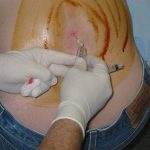 The insertion of a needle between two lumbar vertebrae and through the meningeal wall to obtain cerebrospinal fluid for diagnostic purposes and to provide anesthesia and paralysis of the lower extremities.
The insertion of a needle between two lumbar vertebrae and through the meningeal wall to obtain cerebrospinal fluid for diagnostic purposes and to provide anesthesia and paralysis of the lower extremities.
A surgical procedure to withdraw spinal fluid for analysis or the injection of an anesthetic solution.
A procedure for obtaining a sample of cerebrospinal fluid by inserting a hollow needle into the back between the vertebrae in the lumbar region.
A surgical operation to remove a sample of cerebrospinal fluid by inserting a hollow needle into the lower part of the spinal canal.
Medical procedure involving insertion of a hollow needle (aspiration needle) into the base of the spine, to withdraw cerebrospinal fluid for analysis, generally to test for such conditions as infections, brain hemorrhage, or tumors. Though often done under local anesthesia, the procedure is uncomfortable, but serious side effects are relatively rare-including possible introduction of infection and the risk of tearing the arachnoid membrane that surrounds the spinal cord. Lumbar puncture is also used as part of some other medical procedures, such as a myelogram. An alternative or complement to the lumbar puncture is the cisternal puncture, in which a small amount of fluid is removed from the base of the brain.
insertion of a hollow needle into the subarachnoid space of the lumbar region of the spinal cord for diagnostic (e.g., to obtain a sample of cerebrospinal fluid for analysis) or therapeutic (e.g., to remove blood or pus or inject a drug) purposes. Adverse effects of the procedure include headache, nausea, and infection. Also called spinal tap; spinal puncture.
Diagnostic procedure that entails removal of cerebral spinal fluid from the subarachnoid space.
Aspiration of fluid from the spinal canal through a needle, to diagnose stroke, infection, tumor, or other conditions, or to determine the extent of injury after head, neck, or back trauma.
Also known as a spinal tap, a procedure that involves inserting a needle into the spinal canal to remove a sample of cerebrospinal fluid (CSF). A lumbar puncture is most commonly performed to diagnose problems such as a subarachnoid hemorrhage, encephalitis, meningitis, multiple sclerosis, Guillain-Barre syndrome, Reye syndrome, polio, and tumors or inflammation of the brain or spinal cord. Less commonly, it is done to administer drugs, such as antibiotics or anesthetics, or to remove spinal fluid in order to decrease spinal fluid pressure.
A procedure in which cerebrospinal fluid is withdrawn by means of a hollow needle inserted into the subarachnoid space in the region of the lower back (usually between the third and fourth lumbar vertebrae). The fluid thus obtained is examined for diagnostic purposes. The procedure is usually without risk to the patient, but in patients with raised intracranial pressure it may be hazardous and the optic fundi must be examined for the presence of papilledema.
A procedure for removing cerebrospinal fluid (CSF) from the spinal canal in the lumbar region in order: (1) to diagnose disease of the nervous system; (2) to introduce medication spinal anaesthetics or drugs. A hollow needle is inserted into the lower section of the spinal cord and the cerebrospinal fluid withdrawn. The procedure should not be done too rapidly or the subject may develop a severe headache. Examination of the cerebrospinal fluid helps in the diagnosis and investigation of disorders of the brain and spinal cord for example, meningitis and subarachnoid haemorrhage. When using the procedure to inject drugs into the CSE, the operator must take care to inject only those agents specifically approved for CSF injection.
Gaining entry into the subarachnoid space of the meningeal sac below the end of the spinal cord, usually at the level of the fourth intervertebral space with a hollow needle. This procedure is done to obtain cerebrospinal fluid (CSF) for analysis (e.g., in the diagnosis of severe headache or in suspected central nervous system infection or bleeding); to administer drugs to the brain or spinal cord (e.g., anesthetics or chemotherapeutic agents); or to relieve the CSF of excess pressure or fluid (e.g., in pseudotumor cerebri).
A diagnostic procedure that uses a hollow needle to penetrate the spinal canal at the level of third-fourth or fourth-fifth lumbar vertebrae to remove cerebrospinal fluid for analysis. This procedure is used to examine the cerebrospinal fluid for changes in composition that are characteristic of MS (e.g., elevated white cell count, elevated protein content, the presence of oligoclonal bands).
A medical procedure, commonly known as a spinal tap, involves the utilization of a slender needle to extract a sample of cerebrospinal fluid from the region surrounding the spine. This diagnostic procedure serves the purpose of obtaining valuable fluid for analysis and evaluation, aiding in the identification of various medical conditions. Understanding the significance and methodology of this procedure assists in recognizing its role in diagnosing and managing specific neurological conditions.
A technique involving the insertion of a hollow needle into the lower region of the spinal canal, positioned between two lumbar vertebrae. This is done to extract cerebrospinal fluid or to administer drugs and other substances through the needle.
Lumbar puncture is typically performed to gather a cerebrospinal fluid sample, aiding in the diagnosis and exploration of brain and spinal cord conditions like meningitis and subarachnoid hemorrhage. This procedure lasts approximately 15 minutes and is conducted with the use of local anesthesia.
The process involves inserting a needle into the spinal canal. This procedure is utilized to measure cerebrospinal fluid pressure, collect fluid samples for analysis, administer drugs for specific conditions, or introduce anesthetics. The skin is first numbed before the needle is inserted between the third and fourth lumbar vertebrae into the spinal canal. Since the spinal cord turns into a bundle of nerves around the third lumbar vertebra, placing the needle below this point ensures the cord isn’t accidentally pierced.
